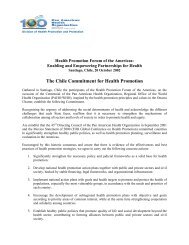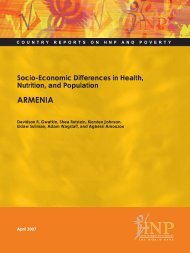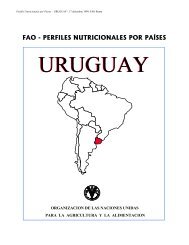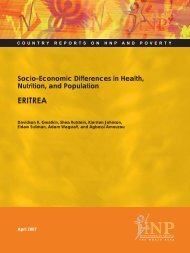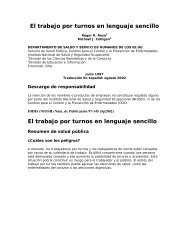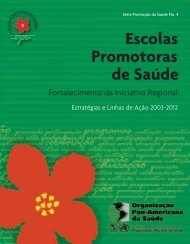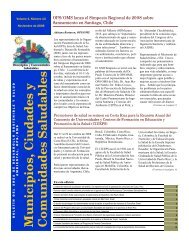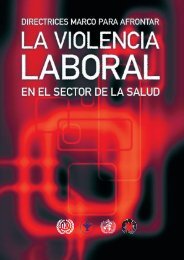Guidelines for drinking-water quality. Volume 1 - BVSDE
Guidelines for drinking-water quality. Volume 1 - BVSDE
Guidelines for drinking-water quality. Volume 1 - BVSDE
You also want an ePaper? Increase the reach of your titles
YUMPU automatically turns print PDFs into web optimized ePapers that Google loves.
provisional health-based guideline value of 0.5 mg/litre should be adequate to protect public<br />
health.<br />
It should be noted that manganese may be objectionable to consumers even at levels below the<br />
provisional guideline value.<br />
Mercury<br />
Mercury is present in the inorganic <strong>for</strong>m in surface and ground <strong>water</strong>s at concentrations usually of<br />
less than 0.5 µg/litre. Levels in air are in the range of 2-10 ng/m 3 . Mean dietary intake of mercury<br />
in various countries ranges from 2 to 20 µg per day per person.<br />
The kidney is the main target organ <strong>for</strong> inorganic mercury, whereas methyl-mercury affects mainly<br />
the central nervous system.<br />
In 1972, JECFA established a provisional tolerable weekly intake (PTWI) of 5 µg/kg of body<br />
weight of total mercury, of which no more than 3.3 µg/kg of body weight should be present as<br />
methylmercury. In 1988, JECFA reassessed methylmercury, as new data had become available,<br />
and confirmed the previously recommended PTWI of 3.3 µg/kg of body weight <strong>for</strong> the general<br />
population, but noted that pregnant women and nursing mothers were likely to be at greater risk<br />
from the adverse effects of methylmercury. The available data were considered insufficient to<br />
allow a specific methylmercury intake to be recommended <strong>for</strong> this population group.<br />
To be on the conservative side, the PTWI <strong>for</strong> methylmercury was used to derive a guideline value<br />
<strong>for</strong> inorganic mercury in <strong>drinking</strong>-<strong>water</strong>. As the main exposure is from food, a 10% allocation of<br />
the PTWI to <strong>drinking</strong>-<strong>water</strong> was made. The guideline value <strong>for</strong> total mercury is 0.001 mg/litre<br />
(rounded figure).<br />
Molybdenum<br />
Concentrations of molybdenum in <strong>drinking</strong>-<strong>water</strong> are usually less than 0.01 mg/litre. However, in<br />
areas near mining sites, molybdenum concentrations as high as 200 µg/litre have been reported.<br />
Dietary intake of molybdenum is about 0.1 mg per day per person. Molybdenum is considered to<br />
be an essential element, with an estimated daily requirement of 0.1-0.3 mg <strong>for</strong> adults.<br />
No data are available on the carcinogenicity of molybdenum by the oral route. In a 2-year study of<br />
humans exposed through their <strong>drinking</strong>-<strong>water</strong>, the NOAEL was found to be 0.2 mg/litre. There are<br />
some concerns about the <strong>quality</strong> of this study. An uncertainty factor of 10 would normally be<br />
applied to reflect intraspecies variation. However, as molybdenum is an essential element, a<br />
factor of 3 is considered to be adequate. This gives a guideline value of 0.07 mg/litre (rounded<br />
figure).<br />
This value is within the range of that derived on the basis of results of toxicological studies in<br />
animal species and is consistent with the essential daily requirement.<br />
Nickel<br />
The concentration of nickel in <strong>drinking</strong>-<strong>water</strong> is normally less than 0.02 mg/litre. Nickel released<br />
from taps and fittings may contribute up to 1 mg/litre. In special cases of release from natural or<br />
industrial nickel deposits in the ground, the nickel concentration in <strong>drinking</strong>-<strong>water</strong> may be even<br />
higher. The average daily dietary intake is normally 0.1-0.3 mg of nickel but may be as high as<br />
0.9 mg with an intake of special food items.<br />
The relevant database <strong>for</strong> deriving a NOAEL is limited. On the basis of a dietary study in rats in<br />
which altered organ-to-body weight ratios were observed, a NOAEL of 5 mg/kg of body weight<br />
per day was chosen. A TDI of 5 µg/kg of body weight was derived using an uncertainty factor of




